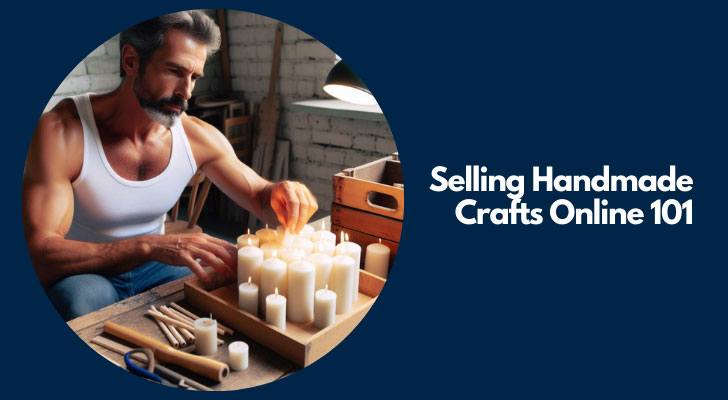So you've got a knack for making cool handmade crafts and you're thinking about selling them online? Idea is good, but you know the market is insanely competitive, don't you? The least you can do first of all, is to find out how you can turn your hobby into a little business. So here it goes.
What Kind of Items Can I Craft and Sell?
Crafting can take you into some really unique and niche areas. Here are 20 examples of lesser-known crafts that are both interesting and special:
- Terrarium Miniatures: Tiny, detailed landscapes inside glass terrariums.
- Handmade Kaleidoscopes: Creating these optical toys with unique designs.
- Book Nooks: Miniature dioramas that fit between books on a shelf.
- Artisanal Soap Making: Especially soaps with unusual shapes and ingredients.
- Resin Jewelry with Real Flowers: Preserving tiny flowers in clear resin.
- Handcrafted Wind Chimes: Using unique materials like driftwood or recycled metal.
- Custom Lino Printmaking: Carving linoleum for custom print designs.
- Felted Wool Animals: Tiny, lifelike animals made from felted wool.
- Handmade Candles with Hidden Gems: Candles that reveal crystals as they melt.
- Quilling Art: Intricate designs made from rolled paper strips.
- Miniature Pottery: Crafting tiny, detailed pottery pieces.
- Ethical Taxidermy: For those with a fascination for natural history.
- Artisanal Incense Making: Crafting unique scents with natural ingredients.
- Customized Leather Book Covers: Hand-crafted, embossed book covers.
- Handmade Fishing Lures: Especially artistic or vintage-style lures.
- Pressed Flower Art: Using real flowers to create lasting artwork.
- Witch Balls: Colorful, glass-blown spheres believed to ward off evil spirits.
- Artisanal Birdhouses: Unique, artistic homes for feathered friends.
- Fairy Garden Accessories: Tiny, detailed accessories for fairy gardens.
- Custom Pet Portrait Embroidery: Hand-embroidered portraits of pets.
Getting Started: Setting Up Shop
First things first, you need a place to sell your stuff. There are a few options here. Websites like Etsy are super popular for handmade goods. It's pretty easy to set up a shop there. You could also consider selling on platforms like eBay or even setting up your own website.
Etsy:
- Go to Etsy.com and click on "Sell on Etsy".
- Sign up for an account if you don't already have one.
- Follow the prompts to open a new shop.
- Etsy will guide you through choosing your shop name, setting your language, currency, and location.
Shopify:
- Visit Shopify.com and start a free trial.
- Fill in the required details to set up your account.
- Choose a theme for your shop and customize it to your liking.
- Add your products, set prices, and configure shipping options.
eBay:
- Go to eBay.com and register for an account.
- Click on "Sell" at the top of the page.
- Follow the steps to list your first item, including choosing a category, setting a price, and adding a description.
Your Own Website:
- Choose a website using WordPress-enabled web hosting service.
- Install WooCommerce plugin for free.
- Sign up and select a template for your online store.
- Customize the design with your branding.
- Add product pages, set prices, and establish shipping and payment methods.
Branding Your Craft Shop
Creating a brand for your online shop is like dressing up your store to make a great first impression. Let's go through some key steps.
Choosing a Shop Name
Picking the right name for your shop is a bit like naming a pet – it should be fun and reflect your style. Your shop name should be easy to remember and give a hint about what you sell. It could be something personal, like your name or a nickname, combined with a word that describes your craft.
For example, "Eric's Enchantments" for a shop selling handmade candles, or "Blue Ridge Woodworks" for custom woodworking. The name should be catchy and unique, but also simple enough that people can easily spell and remember it, right?
Logo and Branding
Your logo is like your shop's smiling face – it's one of the first things people see. You don’t need to be a pro designer for this. There are plenty of free tools online like Canva or LogoMakr where you can play around with designs. Think about what represents your brand – maybe a specific craft tool, a particular shape, or even just a stylish version of your shop's name.
Choosing a color scheme is also part of the fun. Pick colors that reflect your products and style. Soft, earthy tones can be great for natural or vintage items, while bright and bold colors might suit more modern, funky crafts. Stick to two or three main colors so your branding stays consistent and recognizable, you know?
Banner
Your shop's banner is like a billboard. It's a larger space to show off your brand's style. You can use a photo of your crafts, a cool graphic that goes with your logo, or even a picture of yourself working on your crafts. This image should tell a story about what you sell and who you are as a maker.
Your profile picture, usually smaller, is often your logo. It appears next to your shop name in searches and listings, so it should be clear and easy to identify. Keep it simple and consistent with your overall branding.
Your shop's branding should create a story that connects with your customers. Play around with ideas and see what feels right for your shop. It's all part of the journey in making your craft business uniquely yours.
Photography: Show Off Your Work
Okay, so you've got your shop. Now, let's talk about getting people to notice your crafts. Good photos are key. You don't need a fancy camera – a smartphone will do just fine. Just make sure your pictures are clear, well-lit, and show off your craft from different angles.
Lighting
Good lighting is everything, isn't it? You don't need fancy equipment for this. Natural light is your best friend. Try to take photos during the day when there's plenty of sunlight. Set up near a window where the light is soft but bright. Avoid direct sunlight though, as it can create harsh shadows. Overcast days are surprisingly good for photography because the clouds diffuse the light, giving a soft glow to your crafts.
If you're shooting indoors, make sure the room is well-lit. You can even use a white sheet or a piece of cardboard to reflect light onto the darker side of your craft, balancing the light across the item. This simple trick can really improve your photos.
Background
The background matters a lot, you know? You want your craft to be the star of the show, so choose a background that doesn't steal the spotlight. A plain, neutral-colored background works best. Think white, light grey, or soft pastel. This helps in making your craft pop in the photo.
Avoid cluttered or busy backgrounds. They can distract from your item. If you're selling a small item, you can use a piece of fabric or paper as the background. For larger items, a clean, uncluttered table or space on the floor against a plain wall works great.
Composition
Your crafts have unique details and angles, right? Show them off! Don't just stick to one standard front-on photo. Take shots from multiple angles – top, side, 45-degree angles, and any other angle that highlights the special features of your craft.
Think about the composition of your photos. Use the 'rule of thirds' – imagine your image is divided into nine equal segments by two vertical and two horizontal lines. Try to position the most interesting part of your craft along these lines or at their intersections. This technique is pleasing to the eye and makes for a great photo.
Focus
Nothing ruins a good photo like blurriness, you see? Always make sure your craft is in sharp focus. Most smartphones and cameras have a focus feature – tap on the screen or press the button halfway to focus before taking the picture.
If your hands are a bit shaky, use a tripod or rest your camera on a steady surface. Even a stack of books can work as an impromptu tripod. And if your camera has a timer function, use it. This avoids any shake from pressing the button.
Editing
Editing can enhance your photos, but don't go overboard. Use basic editing tools to adjust the brightness, contrast, and saturation if needed. Make sure the colors in the photo match the real colors of your craft.
Apps like VSCO, Lightroom, or even the editing tools on your phone can be really helpful. Remember, the goal is to enhance, not to completely alter your photos. People appreciate authenticity, especially when it comes to handmade items.
Descriptions: Tell the Story
When you list an item, your description should do more than just state the facts. Tell the story behind your craft. Why did you make it? What's special about it? This personal touch can really make your items stand out. For example;
Handwoven Basket
"Each of these baskets is woven from locally sourced willow, inspired by my grandmother's traditional weaving techniques. Perfect for cozy home decor, they carry the warmth of family memories and the rustic charm of the countryside. Ideal for those who cherish handmade heirlooms and the stories they hold."
Ceramic Coffee Mug
"This mug was born from my love for morning rituals. Handcrafted with care, its unique glaze pattern mimics the serene ocean waves at dawn. It's not just a mug; it's a piece of art that brings a moment of peace with every sip. Ideal for anyone seeking tranquility in their daily routine."
Hand-Stamped Silver Necklace
"Inspired by stargazing nights in the mountains, this necklace's pendant features a hand-stamped constellation design. Each piece is a reminder of the vast beauty of the universe and our place within it. It's a perfect gift for dreamers and star lovers alike, connecting us with the cosmos."
Pricing, Payments, and Shipping
Setting prices, handling payments, and figuring out shipping might seem daunting, but let's break it down into manageable steps.
Pricing: How Much to Charge?
Pricing your crafts is a balance between covering your costs and staying attractive to customers, right? Here’s a straightforward method:
- First, calculate the cost of materials for each item.
- Then, decide on an hourly wage for yourself and estimate how long it takes to make one item.
- Add these two together, and you've got your base cost.
- Consider overhead costs like fees for selling platforms, packaging, and a little extra for unexpected expenses.
- Once you have the total cost, add a profit margin. A standard margin is around 20-50% above your costs, depending on how unique your craft is.
Comparing your prices with similar products in the market can also guide you. Just make sure you're not undervaluing your work. Your time and skill are worth something, you know?
Payments: Making Transactions Smooth
Accepting payments online is simpler than you might think. Most online marketplaces like Etsy or Shopify have built-in payment systems. These platforms handle transactions for you, accepting credit cards, PayPal, and other payment methods.
If you have your own website, PayPal and Stripe are popular choices. They're easy to set up – you just create an account, link your bank account, and then integrate the payment service into your site. Most website builders have guides on how to do this.
Always ensure your payment gateway is secure. This builds trust with your customers and protects both of you from fraud, you see?
Shipping: Getting Your Crafts to Customers
Shipping can vary a lot depending on what you're selling.
- Start by finding suitable packaging. Your items should arrive safely, so use bubble wrap, foam, or other protective materials for delicate crafts. You can buy these supplies in bulk to save money.
- Next, decide how you'll ship. If you're in the U.S., USPS is a common choice for small businesses because of their reasonable rates for small packages. UPS and FedEx are also options, especially for larger items. Use their online calculators to estimate shipping costs based on size and weight.
- Consider offering free shipping and including the shipping cost in your item price. This is a great selling point, isn't it?
- Alternatively, charge a flat rate or calculate shipping based on the customer’s location.
Lastly, set up a system for tracking your shipments. Most shipping services offer tracking numbers. Share these with your customers so they can see where their package is.
Add Policies
Write clear policies for your shop. This should include your return and exchange policies, shipping policies, and any other important information customers should know.
Here are examples of common types of policies you should consider:
Return and Exchange Policies
- Return Window: Specify the time frame within which returns are accepted (e.g., 30 days from purchase).
- Condition of Items: State that items must be returned in their original condition.
- Refund Process: Explain how refunds are issued (e.g., to the original payment method).
- Custom Orders: Mention if custom or personalized items are non-returnable.
Shipping Policies
- Processing Time: Indicate how long it takes to prepare an order for shipping.
- Shipping Methods: List the shipping carriers and services you offer (e.g., standard, expedited).
- International Shipping: Clarify if you ship internationally and any specific terms related to it.
- Customs and Duties: Note that buyers are responsible for any customs and import taxes that may apply.
Payment Policies
- Accepted Payments: List the payment methods you accept (e.g., credit cards, PayPal).
- Payment Timing: If applicable, mention when payment is due (e.g., immediate payment for online purchases).
Additional Policies
- Custom Orders: Provide details on how customers can request custom orders and any additional terms.
- Gift Wrapping: State if you offer gift wrapping services and any associated costs.
- Damages and Losses: Outline your policy for items lost or damaged during shipping.





